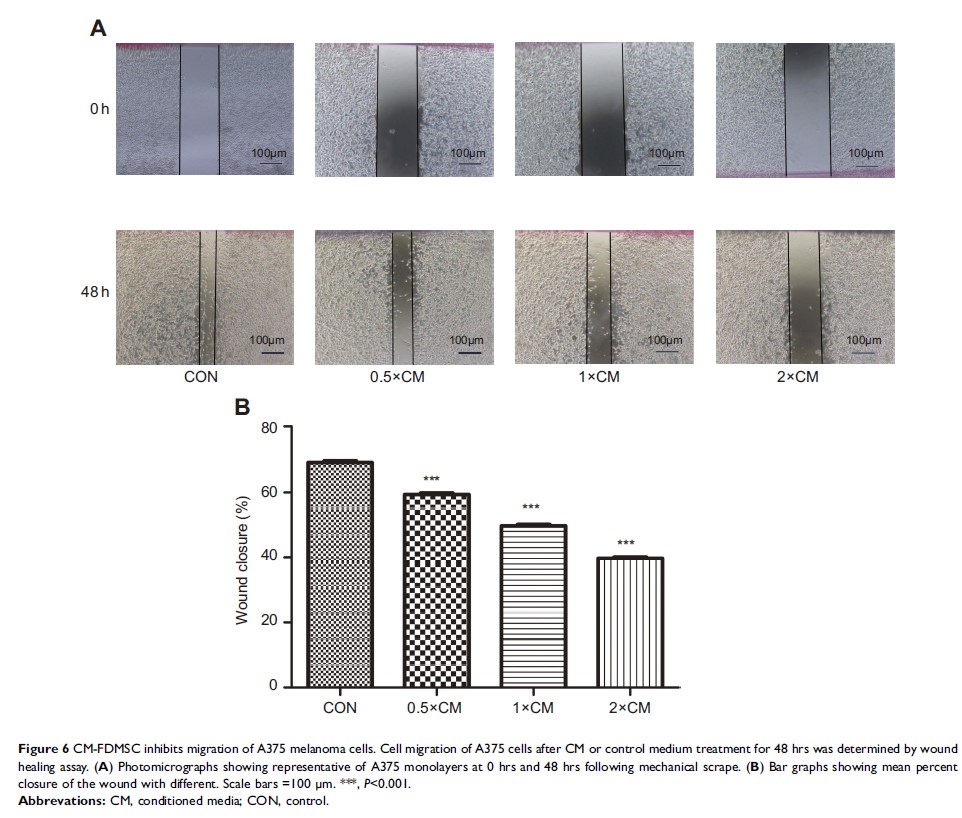9 0 5 7 8
论文已发表
注册即可获取德孚的最新动态
IF 收录期刊
- 2.6 Breast Cancer (Dove Med Press)
- 3.9 Clin Epidemiol
- 3.3 Cancer Manag Res
- 3.9 Infect Drug Resist
- 3.6 Clin Interv Aging
- 4.8 Drug Des Dev Ther
- 2.8 Int J Chronic Obstr
- 8.0 Int J Nanomed
- 2.3 Int J Women's Health
- 3.2 Neuropsych Dis Treat
- 4.0 OncoTargets Ther
- 2.2 Patient Prefer Adher
- 2.8 Ther Clin Risk Manag
- 2.7 J Pain Res
- 3.3 Diabet Metab Synd Ob
- 4.3 Psychol Res Behav Ma
- 3.4 Nat Sci Sleep
- 1.9 Pharmgenomics Pers Med
- 3.5 Risk Manag Healthc Policy
- 4.5 J Inflamm Res
- 2.3 Int J Gen Med
- 4.1 J Hepatocell Carcinoma
- 3.2 J Asthma Allergy
- 2.3 Clin Cosmet Investig Dermatol
- 3.3 J Multidiscip Healthc

人胎儿真皮间充质干细胞条件培养基对黑素瘤细胞的抗肿瘤作用
Authors Sun B, Wang X, Pan Y, Jiao Y, Qi Y, Gong H, Jiang D
Received 2 February 2019
Accepted for publication 12 April 2019
Published 28 May 2019 Volume 2019:12 Pages 4033—4046
DOI https://doi.org/10.2147/OTT.S203910
Checked for plagiarism Yes
Review by Single-blind
Peer reviewers approved by Ms Aruna Narula
Peer reviewer comments 2
Editor who approved publication: Dr Sanjay Singh
Background: Malignant
melanoma is the most lethal form of cutaneous tumor and has a high metastatic
rate and motility capacity. Owing to the poor prognosis, it is urgent to seek
an effective therapeutic regimen. Human mesenchymal stem cells (MSCs) can home
to tumor cells and have been shown to play important roles in both promoting
and inhibiting tumor development. Fetal dermal MSCs (FDMSCs), derived from
fetal skin are a novel source of MSCs. Nevertheless, the antitumor capacity of
FDMSCs on malignant melanoma is not clearly understood.
Materials and methods: FDMSCs
were extracted from the dorsal skin of fetal tissues. A375 melanoma cells lines
were obtained from American Type Culture Collection. The effects of conditioned
media from FDMSCs (CM-FDMSC) on A375 melanoma cells were tested in vivo using
tumor formation assay and in vitro using cell viability,
5-ethynyl-2ʹ-deoxyuridine incorporation, flow cytometry, TdT-mediated dUTP
Nick-End Labeling (TUNEL), wound healing, transwell invasion, and Western
blotting.
Results: CM-FDMSC
inhibited A375 tumor formation in vivo. In vitro, CM-FDMSC inhibited the
tumor-related activities of A375 melanoma cells, as evidenced reductions in
viability, migration, and invasion. CM-FDMSC-treated A375 cells showed
decreased phosphatidylinositol 3-kinase (PI3K), protein kinase B (AKT), and
extracellular signal-regulated kinase (ERK) phosphorylation, and up-regulation
of Bcl-2-Associated X (BAX) and down-regulation of B-cell lymphoma-2 (BCL-2)
expression.
Conclusion: CM-FDMSC
can inhibit the tumor-forming behaviors of A375 melanoma cells and inhibit
PI3K/AKT and mitogen-activated protein kinase signaling to shift their
BCL-2/BAX ratio toward a proapoptotic state. Identification of the bioactive
components in CM-FDMSC will be important for translating these findings into
novel therapies for malignant melanoma.
Keywords: human
fetal dermal mesenchymal stem cells, melanoma, conditioned media, apoptosis,
PI3K/AKT signaling pathway, MAPK signaling pathway
